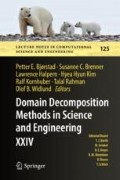Abstract
In this paper we present a framework for Fluid-Structure Interaction simulations. Taking inspiration from the Immersed Boundary technique introduced by Peskin (J Comput Phys 10(2):252–271, 1972) we employ the finite element method for discretizing the equations of the solid structure and the finite difference method for discretizing the fluid flow. The two discretizations are coupled by using a volume based L 2-projection approach to transfer elastic forces and velocities between the fluid and the solid domain. We present results for a Fluid–Structure Interaction benchmark which describes self-induced oscillating deformations of an elastic beam in a flow channel.
Access this chapter
Tax calculation will be finalised at checkout
Purchases are for personal use only
References
D. Boffi et al., On the hyper-elastic formulation of the immersed boundary method. Comput. Methods Appl. Mech. Eng. 197(25), 2210–2231 (2008)
D. Devendran, C.S. Peskin, An immersed boundary energy-based method for incompressible viscoelasticity. J. Comput. Phys. 231(14), 4613–4642 (2012)
K. Fackeldey et al., Coupling molecular dynamics and continua with weak constraints. Multiscale Model. Simul. 9(4), 1459–1494 (2011)
A.J. Gil et al., The immersed structural potential method for haemodynamic applications. J. Comput. Phys. 229(22), 8613–8641 (2010)
B.E. Griffith, X. Luo, Hybrid finite difference/finite element version of the immersed boundary method. Int. J. Numer. Methods Eng., 1–26 (2012, submitted in revised form). https://doi.org/10.1002/nme
B.E. Griffith, X. Luo, Hybrid finite difference/finite element immersed boundary method. Int. J. Numer. Methods Biomed. Eng. 33(12), e2888 (2017)
R. Henniger, D. Obrist, L. Kleiser, High-order accurate iterative solution of the Navier-Stokes equations for incompressible flows. Proc. Appl. Math. Mech. 7(1), 4100009–4100010 (2007)
C. Hesch et al., A mortar approach for fluid-structure interaction problems: immersed strategies for deformable and rigid bodies. Comput. Methods Appl. Mech. Eng. 278, 853–882 (2014)
R. Krause, P. Zulian, A parallel approach to the variational transfer of discrete fields between arbitrarily distributed unstructured finite element meshes. SIAM J. Sci. Comput. 38(3), C307–C333 (2016)
W.K. Liu et al., Immersed finite element method and its applications to biological systems. Comput. Methods Appl. Mech. Eng. 195(13), 1722–1749 (2006)
M.G.C. Nestola et al., Three-band decomposition analysis in multiscale FSI models of abdominal aortic aneurysms. Int. J. Mod. Phys. C 27(02), 1650017 (2016)
C.S. Peskin, Flow patterns around heart valves: a numerical method. J. Comput. Phys. 10(2), 252–271 (1972)
S. Turek, J. Hron, Proposal for numerical benchmarking of fluid-structure interaction between an elastic object and laminar incompressible flow, in Fluid-Structure Interaction (Springer, Berlin, 2006), pp. 371–385
S. Turek et al., Numerical benchmarking of fluid-structure interaction: a comparison of different discretization and solution approaches, in Fluid Structure Interaction II (Springer, Berlin, 2011), pp. 413–424
Author information
Authors and Affiliations
Corresponding authors
Editor information
Editors and Affiliations
Rights and permissions
Copyright information
© 2018 Springer International Publishing AG, part of Springer Nature
About this paper
Cite this paper
Nestola, M.G.C., Becsek, B., Zolfaghari, H., Zulian, P., Obrist, D., Krause, R. (2018). An Immersed Boundary Method Based on the L 2-Projection Approach. In: Bjørstad, P., et al. Domain Decomposition Methods in Science and Engineering XXIV . DD 2017. Lecture Notes in Computational Science and Engineering, vol 125. Springer, Cham. https://doi.org/10.1007/978-3-319-93873-8_46
Download citation
DOI: https://doi.org/10.1007/978-3-319-93873-8_46
Published:
Publisher Name: Springer, Cham
Print ISBN: 978-3-319-93872-1
Online ISBN: 978-3-319-93873-8
eBook Packages: Mathematics and StatisticsMathematics and Statistics (R0)

